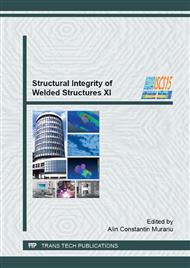p.116
p.121
p.127
p.133
p.139
p.145
p.151
p.157
p.163
On the Influence of Damage-Caused Global Stiffness Decrease upon Structural Modal Parameters
Abstract:
Damage detection using vibration-based methods make use of empirically derived relations to characterize the crack severity. The applicability of these relations is limited to structures with similar cross-section shape and having the same crack type. The use of these relations for composite materials is even more difficult, due to the directional dependency of the materials mechanical properties. We propose in this paper a new method to evaluate the damage severity, which is based on the global stiffness reduction. It is known that the amount of energy stored in a structure depends on its global stiffness, i.e. the value of the structure deflection under a given load. Consequently, the stiffness decrease due to a damage is signalized by an increased deflection. We defined a damage severity indicator based on the evaluation of deflection changes, which is simple to be found by a simple finite element analysis. This indicator is valid for all structures having similar cross-section shape; we used it successfully in vibration-based damage assessment.
Info:
Periodical:
Pages:
139-144
Citation:
Online since:
July 2015
Price:
Сopyright:
© 2015 Trans Tech Publications Ltd. All Rights Reserved
Share:
Citation:


